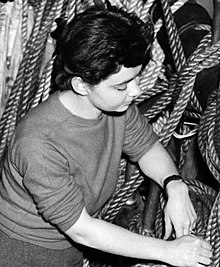Jean Rosenthal

Jean Rosenthal (born Eugenia Rosenthal; March 16, 1912 – May 1, 1969) is considered a pioneer in the field of
In the early part of the 20th century, the lighting designer was not a formalized position; the
Career and education

In 1929, Rosenthal was introduced to
She returned to New York City, where she joined the Federal Theatre Project in 1935. This led to collaborations with Orson Welles and John Houseman. She later followed them to the Mercury Theatre,[2] where she was credited as a member of the board in addition to production and lighting manager, although not as lighting designer.
She was lighting designer for hundreds of productions, including numerous
Contributions
Some of her major contributions were the elimination of shadows by using flood lights from upstage positions and controlling angles and mass of illumination to create contrasts without shadows.[6] "Some of the signature lighting she did for Balanchine and the diagonal shaft of light she created for Graham (lovingly referred to by her as 'Martha's Finger of God'), are now in such widespread use by dance companies of every style that they have become standards of the lighting repertoire."[7]
The Magic of Light
Jean Rosenthal's book, The Magic of Light: The Craft and Career of Jean Rosenthal, Pioneer in Lighting for the Modern Stage, (Little Brown & Co,
The book begins with an autobiography, and goes on to detail the history of illumination, and methods for lighting plays, musicals, operas, and the house. It later details theatrical lighting equipment in use at the time of its publication. The Magic of Light concludes with samples of Rosenthal's paperwork (light plots, hookups, and focus charts), and a list of her lighting credits.[9]
Death
On May 1, 1969, she died of cancer at the age of 57.
References
- ^ a b "Jean Rosenthal biography". Archived from the original on August 24, 2002. Retrieved 2009-05-20.
{{cite web}}: CS1 maint: bot: original URL status unknown (link) northern.edu, retrieved May 20, 2009 - ^ a b c Fippin, Carol.BiographyJewish Women's Archive, 2005, accessed May 24, 2009
- ^ Dunning, Jennifer."Lighting The Way Into A Sense Of Space",The New York Times, October 27, 1996
- ^ Boone, Mary Callahan, "Jean Rosenthal's Light: Making Visible the Magician",Theatre Topics, March 1997, pp. 77-92
- ISBN 0-395-74655-8, p. 106
- ^ "Jean Rosenthal Dies Here at 57". The New York Times. May 2, 1969. Retrieved January 29, 2023.
- ^ West, Martha.The light fantastic,Dance Magazine, February 1996
- ^ listing amazon.com
- ^ Rosenthal, Jean and Lael Wertenbaker (1972). The Magic of Light. Boston: Little, Brown and Company.
External links
- Jean Rosenthal at the Internet Broadway Database
- Jean Rosenthal, 1912-1969 by Larry Wild, Northern State University Archived 2009-06-11 at the Wayback Machine
- The Lighting Archive, online examples of Jean Rosenthal light plots, hookups, shop orders, cue sheets and focus charts
- Jean Rosenthal professional files, 1954-1970 (bulk 1961-1969), held by the Billy Rose Theatre Division, New York Public Library for the Performing Arts
